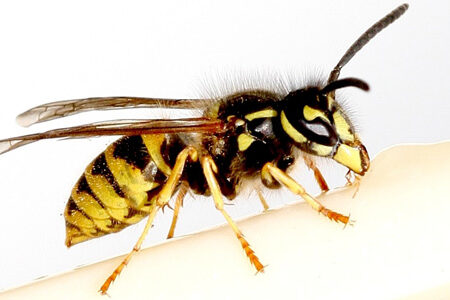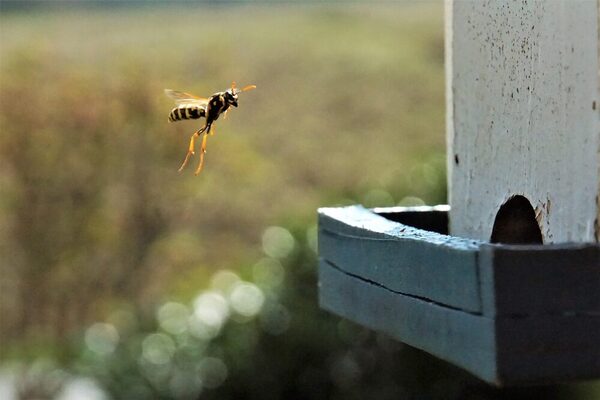Wasps
Wasps are useful insect hunters. They feed their offspring with flies, mosquitoes, aphids and spiders, for example. Wasps also take part in the removal of dead animals. Most wasp species are not interested in the ham on the breakfast table.
Adult animals are dependent on sugary food. The larvae thank the workers for feeding them. To do this, they release a nectar-like liquid that serves as food and reward for the workers. In addition, sugary food is obtained from tree sap, fruit and flower nectar.
Not all wasps are the same
There are 13 native wasp species in Germany that build their nests in a social community. Like all wild animals, all wasp species are under the general protection of the Federal Nature Conservation Act. They may not be killed or their nests destroyed without good reason. The native hornet is even more strictly protected. Even a reasonable reason is not sufficient to take action against the animals or their nests.
The "black sheep" in the family
Only the workers of two species (German wasp and common wasp) can sometimes become quite troublesome in late summer. Both species can develop very large nests. The German wasp and the common wasp never build their nests in direct daylight. However, as there are fewer and fewer natural cavities available, the nest founders also choose shutter boxes, attic openings or other dark places in and around the house as nesting sites.
It often hits the wrong
When the typical wasp season begins in late summer, the nests of other species, such as the median wasp or the Saxon wasp, are already largely dead.
Wasp nests without an integument are inhabited by field wasps. These colonies comprise only a few animals. Nests are only defended if they are clearly disturbed. Field wasps can be easily recognized in flight by their hanging leg posture:
Whenever a nest can be seen openly and is approached by wasps that are rather small, these are species that should be tolerated if possible.
Attention
If the animals are significantly larger and have a rather black body with orange legs, then they could be Asian hornets.
A report should definitely be made in this case. You can find out more on the "Asian hornet" page.
Queens looking for a home - preventing nest building
In spring, young queens are on the lookout for suitable nesting sites.
Of the 10,000 queens born in the previous year, on average only 8 manage to found a functioning colony the following year. The remaining 9,992 queens do not survive the hibernation period or die during the nest-founding phase, as they still have to fly out regularly at this time to look for building materials and food for their own survival and that of their offspring. Here they encounter competing queens and predators who make life difficult for them.
If a queen wasp has just started looking for a nesting place in or around the house, a few squirts of lemon juice or citronella oil are sometimes enough to drive the animal away. If the first combs have been built but no other workers can be seen, you can try to block the queen's way back after she has left the nest. For small entrances, the entrance hole can be sealed. Roller shutter boxes can be secured against re-entry for a few days by lowering the shutter slightly and plugging the slit with paper. If the queen can no longer get into the cavity, she will look for a new location after a few unsuccessful attempts.
If you have already had several nests in a roller shutter box (hornets or other wasps of the species that nest in cavities), then a more permanent protection of roller shutters by attaching brushes or sealing lips, which also optimize the insulation of boxes, can also be recommended. Under "Further information" you will find links to You-Tube articles that explain the systems.
You can also obtain advice and support on installing such systems from specialist retailers for roller shutters.
Avoid removal as far as possible
If the nest is discovered late and the state has already grown considerably, it should only be removed if there is a real danger to humans. With a few precautions and a little consideration, peaceful coexistence can be achieved for one summer. The wasp colony dies off in the fall. The old nest will not be recolonized.
If a nest cannot be left in place, then you should leave the removal to a reputable specialist company.
Further information
Contact us
Environmental store
Address
65185 Wiesbaden
Postal address
65029 Wiesbaden
Arrival
Notes on public transport
Public transportation: Luisenplatz stop.
Telephone
- +49 611 313600
- +49 611 313957
Opening hours
- Monday, Tuesday, Friday Saturday: 10 a.m. to 2 p.m.
- Wednesday, Thursday: 1 to 6 p.m.
Species protection advice
Address
65189 Wiesbaden
Postal address
65029 Wiesbaden
Arrival
Notes on public transport
Bus stop Statistisches Bundesamt; bus lines 16, 22, 27, 28, 37, 45, X26, x72, 262
Telephone
- +49 611 313733
- +49 611 313957
Information on accessibility
- Barrier-free access is available
- The WC is barrier-free


